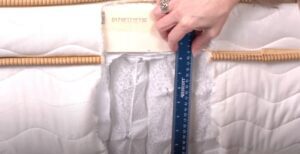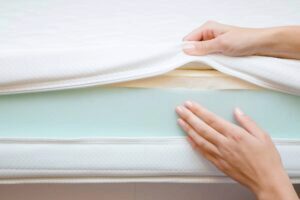Latex vs. Memory Foam
Disclosure: By clicking on the product links in this article, Mattress Nerd may receive a commission fee at no cost to you, the reader. Read full disclosure statement.
In stores and on the web, mattresses are labeled with hundreds of selling points. From touting that a mattress is “aloe vera-infused” to promising your “best sleep ever,” there’s a lot of marketing terms to sort through. Here at The Mattress Nerd, we want to empower you to cut through the clutter as you search. A great place to start when looking for a new mattress, is to educate yourself about the types of mattresses available and their materials.
In this guide, we’re reviewing latex vs. memory foam, two of the most commonly used mattress materials. Read on to learn what they are, what they are made of, and how they measure up in terms of feel, support, and cost.
Watch the Nerds
Mattress Nerds Loren and Corey explain the difference between memory foam and latex beds.
What is Latex?
Latex foam is made from natural materials that are extracted from rubber tree sap. The latex used in mattresses can be; natural latex foam, synthetic latex, or blended latex. It can be expensive in its 100 percent natural form, so some manufacturers will often blend it with synthetic materials to offset the cost. When shopping for a latex mattress, you have to decide if you care more about having the purest materials or saving a few bucks.
Consumers seem to be flocking to mattresses made with latex in troves. This is likely because of the increasing eco-consciousness of society at large. Since latex is made from a natural material, it is naturally hypoallergenic, dust mite resistant, moisture-wicking and friendly to the environment.
For more information, check out our guide to the best latex mattresses.
Different Types of Latex
There are two types of latex, and they’re named after their formulation processes: Dunlop and Talalay.
Dunlop Latex
Dunlop is the older of the two methods and involves filling a mattress mold completely with the latex. The result is a firmer, more dense mattress. In the
Talalay Latex
The Talalay process, the mattress mold is filled only partially with the latex while the rest is filled with air. The result is a lighter, fluffier material that works well as a comfort layer in mattresses.
What is Memory Foam?
Memory foam was originally developed by NASA and has been around since the 1960s. A polyurethane foam material otherwise known as viscoelastic, memory foam is considered synthetic and is sensitive to pressure points and temperature. This makes it especially effective in conforming to an individual’s body. In its construction, the cells, or foam bubbles, are open, creating a matrix that encourages airflow. This material is well known for fitting snugly around the body.
The method of creating memory foam varies by company, as each uses a different formula to enhance various qualities of the foam. Generally speaking, it’s made by reacting different substances with additional agents that create the vicious, denser properties inherent in its construction. The foamy mixture that results may be infused with blowing agents or vacuum-sealed to create the open matrix structure.

Different Types of Memory Foam
Traditional Memory Foam
This memory foam is made with petroleum-based materials and is, in its most basic form, a slab of foam. Traditional memory foam has a reputation for sleeping warm, but it can be great for those searching for pressure relief.
Plant-Based Memory Foam
The manufacturing process of plant-based memory foam involves fewer VOCs (volatile organic compounds) and uses plant-derived oils to create the foams. Most of these foams are noted with a certification based on the practices used in production.
Gel Memory Foam
If you are set on a memory foam mattress but want a cooling mattress, a gel memory foam is your best bet. This is a type of foam that is infused with a cooling gel, and was designed specifically to keep sleepers cool. It feels very similar to traditional memory foam, just cooler.
How Different Mattress Types Perform
Overall Feel
Mattresses with latex generally feel luxuriously comfortable. The material will compress underneath your hips while providing firmer support for your waist and legs. It springs back more quickly than memory foam, which creates a very comfortable sleeping surface. Most mattresses made from latex come in varying levels of firmness, from soft to firm, medium-firm, and extra firm.
Memory foam, on the other hand, provides a dense, yet comfortable surface—it’s a unique feel that most shoppers remember. The material cradles your body and remembers its shape. If you have back pains concerns, memory foam beds can provide real relief due to the cradling. With slow-moving properties, it will remain in the original shape for a few seconds before springing back up once you’ve laid on it. This material has come a long way since it was originally invented, with manufacturers now providing traditional, gel, and even plant-based memory foam, all of which have a different feel.
Heat Retention
Mattresses made with latex are naturally cool and don’t tend to retain heat. This is one of the most attractive selling points for buyers. Talalay in particular proves to remain cooler throughout the night due to its construction, which holds more air and makes it more breathable.
Perhaps one of the greatest pitfalls of memory foam is its tendency to trap body heat. It’s strength and contouring creates this downside, as the sinking effect results in less airflow and increases the amount of material coming into contact with the body. However, mattress designers have begun to release products that mitigate this issue. For example, gel foam layers can create a matrix that allows for more airflow.
Motion Isolation
If you sleep with a partner and are sensitive to motion throughout the night, memory foam won’t allow for motion transfer whatsoever. Your partner could roll over in bed and you wouldn’t feel a thing. Latex, on the other hand, doesn’t isolate motion nearly as well. This is due to the increased bounce of the material and its resilience.
Support
The supportiveness of a mattress is determined by its ability to provide an even surface without indentations or excessive sinking. This is especially key for healthy spinal alignment throughout the night. While mattresses made with either material can provide pressure relief for the spine, neck, and other joints depending on how they’re constructed, natural latex mattresses are generally more durable than memory foam.
The responsiveness of latex prevents it from too much sinking, whereas memory foam can’t withstand lengthy indentations, as it tends to sink more deeply. While sleepers will feel more body contouring with memory foam, it’s a less supportive surface overall.
So, which is right for you?
Latex beds are known for being extremely comfortable and supportive since the material tends to push and elevate the body while contouring in all the right places. Not to mention, latex is eco-friendly and devoid of harsh chemicals and allergens (this means not much off-gassing). We recommend latex for those who want a firm surface with bounce, enjoy a faster response time, want to sleep cool, and value natural materials and eco-friendliness. However, keep in mind that beds made with latex tend to be pricier than other options.
Memory foam is an excellent option if you want deep compression support, a slower response time, and enjoy mattresses made with a variety of materials. Back and side sleepers tend to enjoy the give and contouring properties of the material. However, if you’re a person who’s known to trap heat when you sleep, this probably won’t be the best mattress for you.


